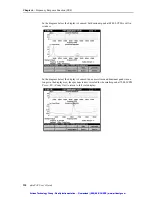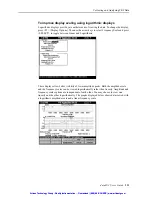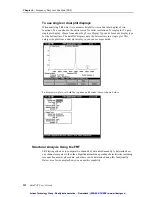
224
dataPAC User’s Guide
Chapter 6 - Frequency Response Function (FRF)
Type
This field is set to Impact at this time, but as new test methods are added to the FRF Module,
this may become a variable setting.
Units
The Units field controls the unit of measure that is used to gauge the amount of impact
force. The units are expressed in either Newtons (N) or Pound-Force (lbf).
Sensitivity
The Sensitivity field expresses the sensitivity of the force hammer, expressed in millivolts
of output per input unit of force. The unit of force is controlled by the Units field. For
instance, if the force hammer has a load cell with 2.3 mV/Newton, you would set the Units
field to Newtons and this field to 2.3. Be careful when setting this field. If the power unit
connected between the force hammer and the dataPAC has a variable amplifier, you must
take into account the amplification setting when entering this value. If the amplifier is set to
10X magnification of the hammer signal in our hammer example, you need to set this field
at 23 instead of 2.3.
Overload
The Overload field detects a hammer blow that has too much total force. It is expressed in
the same force units as the Units field. If a hammer blow force exceeds this amount, the
dataPAC presents an Overload warning dialog during FRF measurement. This field can be
adjusted from the Setup Force Channel screen during dynamic input testing. See “Setting
Up the Force Channel and Response Channel” on page 221. If you are uncertain what value
should be specified here, enter a value that is 10 to 15 times greater than the base sensitivity
of the force hammer and be sure to test and adjust it from the dynamic setup screen.
Underload%
This value detects a hammer blow that probably has insufficient input force to properly
excite all resonant frequencies in the structure being tested. It establishes a “floor” that
serves as a minimum value for the input force. If a hammer blow does not exceed this force
level, the dataPAC presents an Underload warning notification during testing. If you are
uncertain what value to specify here, start with 10% and adjust it as needed from the
dynamic setup screen.
Trigger%
Trigger percentage specifies the force amplitude level where the pretrigger condition is
satisfied and the instrument begins sampling the input and output channels for FFT
processing. By beginning the data sampling as the input force is increasing and not waiting
until peak input is reached, none of the event is lost due to time lag between structural
excitation and data sampling. The trigger percentage is a percentage of the overload value
specified previously. Try using 20% as a starting point and adjust it as necessary from the
dynamic setup screen.
Trigger Slope
The trigger percentage can be triggered by a positive or negative slope. This field controls
which slope direction to trigger on. For frequency response testing, you usually use a
positive slope.
Artisan Technology Group - Quality Instrumentation ... Guaranteed | (888) 88-SOURCE | www.artisantg.com
Artisan Technology Group - Quality Instrumentation ... Guaranteed | (888) 88-SOURCE | www.artisantg.com






























